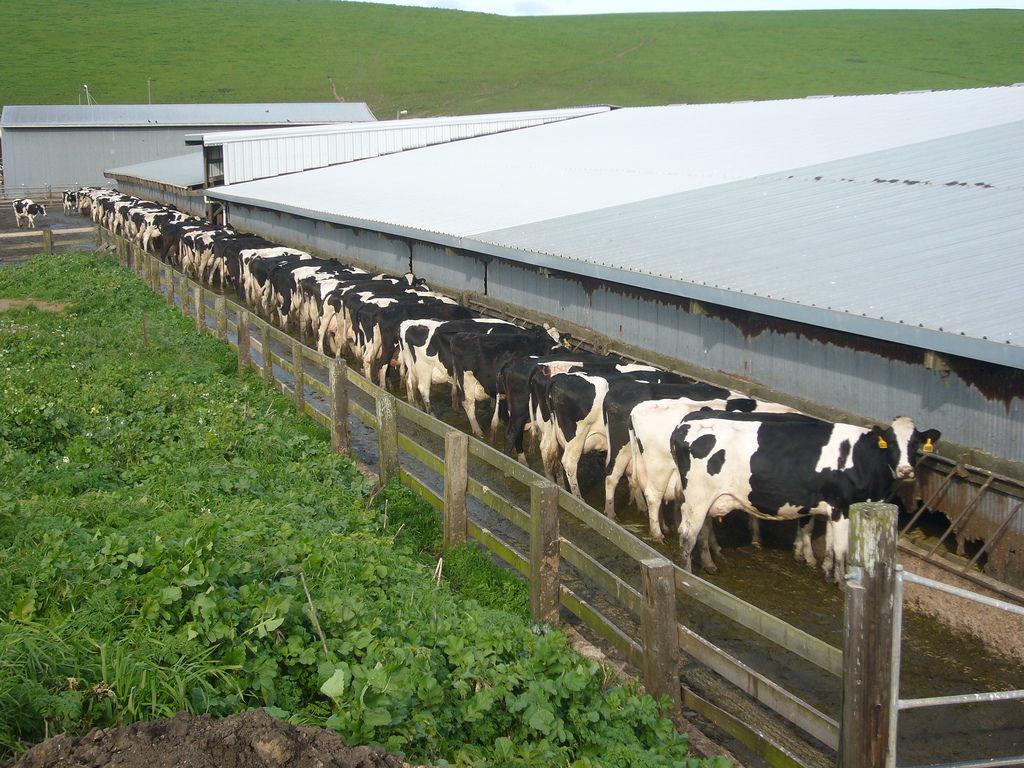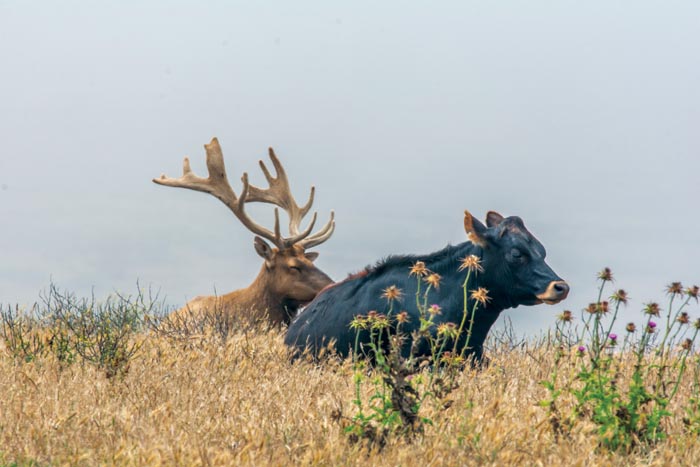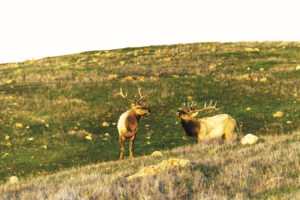A potentially fatal bacterial disease has been found among a free-roaming tule elk herd at Point Reyes National Seashore, raising concerns about the close proximity of wildlife to cattle on national parkland.
Five adult elk from the herd above Drake’s Beach tested positive for Johne’s disease in February, following hundreds of negative results from samples collected since May 2014. Although it’s not known for sure how these elk contracted the disease, which can result in rapid weight loss and diarrhea years later in an animal’s life, it can be rampant in cattle operations. The Drake’s Beach elk herd shares park-owned pastureland with cattle that belong to the Seashore’s historic ranches.
The discovery could complicate the National Park Service’s efforts to relocate tule elk to other areas of the park or elsewhere in the state, an option that’s been under consideration as a management tool for keeping the elk population under control and for minimizing conflict with ranchers.
Ever since the free-roaming elk herd above Drake’s Beach established itself in 1999, ranchers have complained about the amount of forage consumed by the wild native ungulates, and park staff are in the midst of drafting a ranch management plan to dampen the conflict and provide for a sustainable future for both elks and ranchers at the Seashore.
More from Bay Nature: On the Fence
The recovery of tule elk at Point Reyes has been a major conservation success. But it’s raised a dilemma for wildlife management. Bay Nature’s October 2015 story explores the challenge of keeping elk and cows in close proximity at the seashore.
Paratuberculosis is the bacteria that causes an infectious and incurable disease that affects the gastrointestinal system of wild and domestic ungulates — including elk, deer, cows and sheep — and is easily passed between species through feces. Point Reyes’ wildlife biologist Dave Press says he doesn’t know how the tule elk at Drakes’ Beach contracted the disease, but it’s been seen before in the herd stationed at the northern tip of the Seashore at Tomales Point. It is believed the Tomales Point herd initially contracted the disease from remaining cattle operations shortly after the first elk herd was established there in 1978.
In 1999, a group of elk from the Tomales Point herd, which are segregated from nearby ranches by a fence, were relocated to establish the first free-roaming herd in the park’s wilderness area above Limantour Beach. They were first quarantined, and those that were believed to be disease free were released, but some of those animals quickly moved out of the wilderness to the pastoral zone above Drakes’ Beach and began mixing with cattle on pastureland.
“We don’t know whether or not the animals carried the bacteria all the way from Tomales Point,” Press said. “The other possibility is that tule elk picked up Johne’s disease by mixing up with the cattle ranching operation. It’s not uncommon, particularly on dairies, and the elk spend a fair amount of time on dairy pastures.”

Johne’s disease is notoriously difficult to test for and can exist in animals for a long time with few symptoms. To conduct these recent tests, park staff initially sampled fecal matter, but because of the high likelihood of false negatives in such tests the park service moved on to more extensive tests on gut tissue, Press said. The gut tissue tests required euthanization in order to obtain the samples, and so the park service put down 15 animals and sent them in for necropsies at a Johne’s testing center at the University of Wisconsin, where five of the samples came back positive with the disease, according to Press.
The park service plans to euthanize two more animals, this time from the Limantour herd, and test them for the disease. They are also working on determining were the disease came from and are having the lab do a genetic analysis between the recently found bacteria and ones dating back to 1999 in the animals relocated from Tomales Point (the lab is the same one that was previously used and retains the old samples). If the two are similar, that would point to Johne’s persisting all this time in the herd, but if the two bacteria are different it would mean a more recent transmission from another source, perhaps cattle.
Finding the answer makes a difference in whether the park service can move elk elsewhere without risk of passing the disease to a new herd in a new location.
“If we can demonstrate that the National Park Service was successful at that one point in time (1999) in establishing a Johne’s disease-free herd then we can do that again through quarantining animals,” Press said.
But Joe Hobbs, the elk coordinator for the California Department of Fish and Wildlife, said NPS’ case for relocating some of the Point Reyes elk to new areas of the state has gotten more complicated with the recent Johne’s discovery.
“Nothing is off the table but it adds another layer,” Hobbs said. “We need to be careful what we do.”

The results drew the immediate ire of longstanding critics of cattle ranching at the Seashore. The Center for Biological Diversity recently filed a federal lawsuit to force the park service to prepare an environmental impact statement on ranching and update its 35-year-old general management plan for the Seashore before extending cattle grazing leases. CBD’s Jeff Miller questioned why elk were being tested, while the ranchers aren’t being required to test their cattle before letting them loose on park land.
“You’ve got a private enterprise on public land in a national park and they may be spreading a disease to wildlife,” he said. “And now because of the disease the park service is killing wildlife for testing and not requiring ranchers to test for the disease. That’s insane.”
Miller pointed out that the park service allows dairy farmers to spray manure on pastureland, a practice that, he said, can easily spread the disease to wildlife. Park officials acknowledge that the practice is allowed, and Press said that mandating cattle testing is “not something the National Park Service has ever pursued.”
“I think the reality is, even if we were to implement some measures, Johne’s disease is just present in the landscape at Point Reyes and it has been here, we know, since the 1970s,” he said, noting that black-tailed deer and even rabbits can transmit the disease.
In other news, the 2015 annual December count of tule elk on the Point Reyes peninsula showed no significant change in population from the previous year. The Tomales Point herd, which had dropped by almost half from 2012-2014 during the height of the California drought seems to have stabilized at 283 animals. Press said he believes this year’s rainfall will make conditions good for calving this spring and which should result in an increase in the population by the end of 2016.
And the long-awaited ranch management plan has been delayed another year due to personnel changes and the degree of work involved in detailing how ranchers might diversify their operations to other kinds of enterprises like row crops and B&Bs, according to PRNS spokeswoman Melanie Gunn.
“Prior to the filing of this lawsuit, our plan is to release it for comment this summer or this fall and then have the whole process complete by the end of 2016,” Gunn said.





